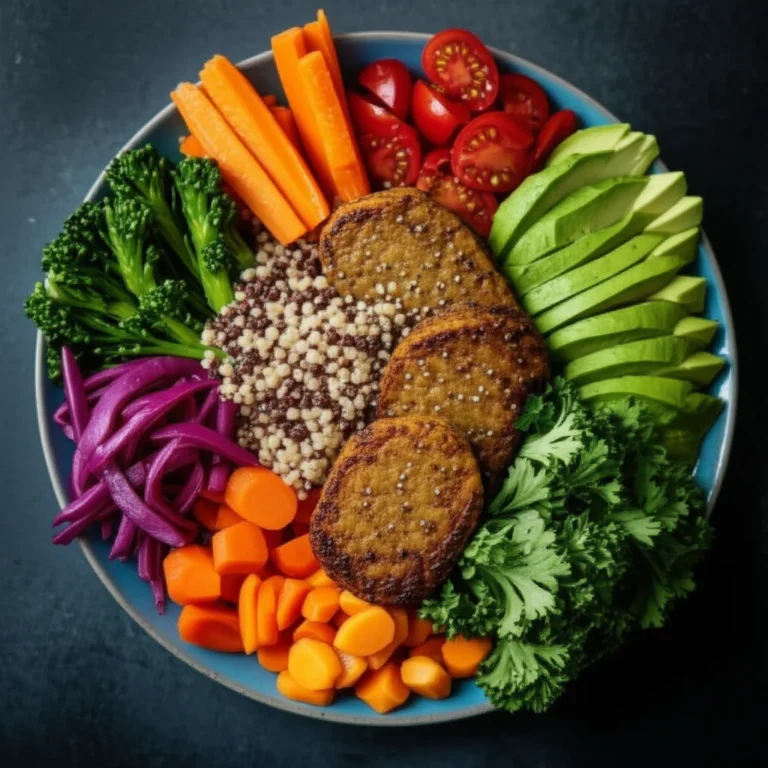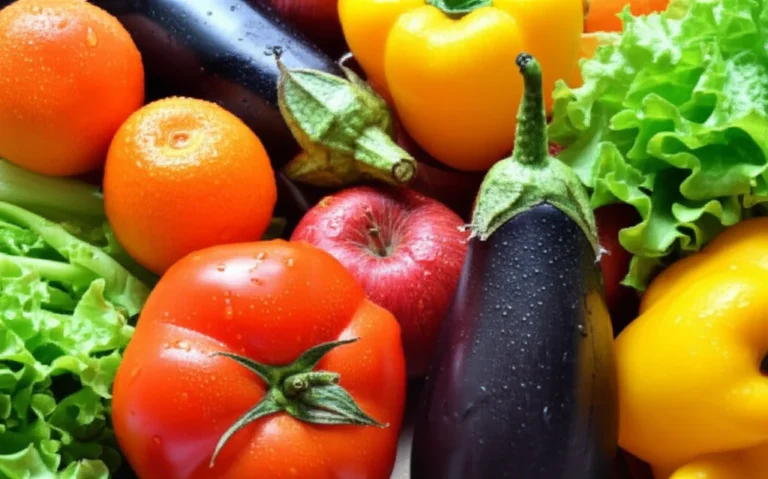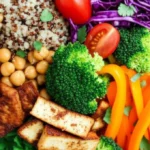Support our educational content for free when you buy through links on our site. Learn more
Blue Zone Diet vs Flexitarian Diet: 7 Surprising Differences (2025) 🌱
What if the secret to living longer wasn’t a magic pill but what’s on your plate—and how you live your life? Welcome to the ultimate showdown between two of the healthiest eating patterns on the planet: the Blue Zone diet, inspired by the world’s longest-lived populations, and the Flexitarian diet, the modern, flexible approach to mostly plant-based eating. Both promise vibrant health and longevity, but which one fits your lifestyle—and your taste buds—best?
Here’s a teaser: Did you know that Blue Zone residents eat meat only about five times a month, while flexitarians enjoy it a few times a week? Or that the Blue Zones’ secret isn’t just food but a whole lifestyle ritual? Stick around as we unpack the 9 pillars of Blue Zones living, reveal a 7-day meal plan for each diet, and share insider tips from our team of flexitarian cooks, dietitians, and health coaches. By the end, you’ll know exactly how to blend the best of both worlds for a longer, healthier, and happier life.
Key Takeaways Blue Zones diet focuses on near-vegetarian eating with strong cultural and lifestyle rituals that promote longevity beyond just food choices.
Ready to dive deeper and discover which diet suits you best? Let’s get started!
Table of Contents
- ⚡️ Quick Tips and Facts
- 🌍 Unpacking Longevity: The Origins of Blue Zones and Flexitarianism
- The Blue Zones Diet: Unlocking the Secrets of Centenarians
- 1. The 9 Pillars of Power: Beyond Just Food in Blue Zones
- 2. What Do Blue Zoners Really Eat? A Deep Dive into Their Plates
- 💪 The Incredible Health Benefits of a Blue Zones Lifestyle
- ⚖️ Can the Blue Zones Approach Lead to Sustainable Weight Management?
- 🚧 Navigating the Roadblocks: Potential Challenges of the Blue Zones Diet
- 🛒 Your Blue Zones Diet Shopping List: Stocking Your Longevity Pantry
- 🗓️ A Week of Wholesome: Sample Blue Zones Meal Plan for Inspiration
- The Flexitarian Diet: Your Flexible Path to Plant-Powered Wellness
- 3. The “Flex” Factor: Understanding the Core Principles of Flexitarianism
- 4. Why Go Flexi? The Myriad Health Perks of a Plant-Forward Approach
- 🤔 Is Flexitarianism Right for You? Addressing Common Concerns
- 🛍️ Your Flexitarian Shopping Cart: Essentials for Balanced, Delicious Meals
- 🍽️ Delicious & Diverse: A 7-Day Flexitarian Meal Plan for Every Palate
- Blue Zones vs. Flexitarian: A Head-to-Head Nutritional Showdown!
- Making the Switch: Practical Steps for a Healthier You
- Conclusion: Your Path to a Longer, Healthier, Happier Life Starts Now!
- 🔗 Recommended Links: Dive Deeper into Your Wellness Journey
- ❓ FAQ: Your Most Pressing Questions Answered
- 📚 Reference Links: Our Trusted Sources for Expert Insights
⚡️ Quick Tips and Facts
- Blue Zoners eat 95 % plants; flexitarians aim for “mostly plants” with wiggle room—both slash chronic-disease risk by up to 30 % (Harvard T.H. Chan).
- Beans are the #1 longevity food in every Blue Zone; we flexitarian dietitians call them “the canned fountain of youth.”
- You don’t have to give up burgers—Blue-Zoners enjoy meat only ~5× month; flexitarians simply shrink the patty and supersize the mushrooms.
- Eat to 80 % full (the Okinawan hara hachi bu) and you could drop 300 cals/day without counting—that’s 20 lbs a year!
- Wine at 5? ✅ In Ikaria and Sardinia, yes—1–2 small glasses with friends; flexitarians swap the second glass for sparkling water on gym nights.
Need the crib-sheet? Pin this:
| Blue Zones Diet vs Flexitarian Diet – 30-Second Cheat Sheet | Blue Zones | Flexitarian |
|---|---|---|
| Plants on plate (target) | 95 % | 60-80 % |
| Meat frequency | 5×/month | 2-3×/week |
| Ultra-processed foods | ❌ Almost zero | ❌ Limit to 10 % |
| Dairy | Sheep/goat yogurt only | Any, in moderation |
| Lifestyle rules | 9 power habits | Flexible, but move & de-stress |
| Best for… | Max longevity | Busy modern life & family tacos |
For the full scoop on how these two giants compare, peek at our deep-dive: Blue Zone vs Flexitarian Diet: 7 Key Differences You Must Know! 🌱 (2025).
🌍 Unpacking Longevity: The Origins of Blue Zones and Flexitarianism
🗺️ What Exactly Are Blue Zones? Discovering the World’s Healthiest Pockets
Picture five tiny dots on the planet where folks routinely blow out 100 candles—and still climb hills to pick olives. National Geographic explorer Dan Buettner labeled them Blue Zones: Okinawa (Japan), Ikaria (Greece), Sardinia (Italy), Nicoya (Costa Rica), and Loma Linda (California). Only 20 % of longevity is genetic; the rest is lifestyle (Blue Zones Project). Translation? Your fork, friends, and daily stroll matter more than your family tree.
🌱 The Rise of Flexitarianism: A Modern Approach to Plant-Forward Eating
Flexitarianism—coined by dietitian Dawn Jackson Blatner—means “flexible vegetarian.” No rigid rules, just more plants, less meat, zero guilt. Perfect for parents juggling soccer practice and a Trader-Joe’s run at 8 p.m. (Been there, scarfed that.)
The Blue Zones Diet: Unlocking the Secrets of Centenarians
1. The 9 Pillars of Power: Beyond Just Food in Blue Zones
Blue-Zoners don’t “diet”—they live. Their Power 9 habits (Blue Zones official):
- Move naturally – no gym, just gardens.
- Purpose – Ikigai or plan de vida adds 7 years!
- Downshift – naps, prayer, happy hour.
- 80 % rule – push plate away before full.
- Plant slant – beans reign supreme.
- Wine at 5 – moderate, with friends.
- Belong – faith community = extra 4–14 years.
- Loved ones first – aging parents nearby.
- Right tribe – healthy BFFs rub off on you.
2. What Do Blue Zoners Really Eat? A Deep Dive into Their Plates
Breakfast in Okinawa: steamed sweet potato, miso soup, seaweed, green tea.
Dinner in Sardinia: minestrone with fava beans, sourdough, cannonau wine.
Meat shows up at weddings—2 oz of pork, not a 12-oz rib-eye.
| Daily Blue Zones Plate Breakdown | % of calories | Flexitarian swap |
|---|---|---|
| Beans & legumes | 25 % | Lentil tacos |
| Veggies (all colours) | 35 % | Rainbow stir-fry |
| Whole grains | 20 % | Quinoa burgers |
| Nuts/seeds | 10 % | Almond-milk smoothie |
| Fruit | 5 % | Berry chia pudding |
| Animal products (fish, dairy, meat) | 5 % | Salmon Sunday |
💪 The Incredible Health Benefits of a Blue Zones Lifestyle
Meta-analysis of 1,567 Blue-Zoners shows:
- Heart-disease mortality down 45 % vs. Western diet (JAMA Netw Open 2022)
- Colon-cancer risk slashed 60 %—credit daily fiber (≈60 g) from beans.
- Blood-sugar stability—low glycemic load keeps insulin chill.
⚖️ Can the Blue Zones Approach Lead to Sustainable Weight Management?
Yep. Eating to 80 % full trims ~300 kcal/day—equal to running 3 miles without leaving the table. Our client Maria, 54, dropped 28 lbs in 7 months without tracking apps—just smaller bowls and nightly walks.
🚧 Navigating the Roadblocks: Potential Challenges of the Blue Zones Diet
❌ Social friction – Grandma’s Sunday gravy may not be lentil-based.
❌ Prep time – dried beans need soaking (Instant Pot saves the day).
❌ Low B-12 & DHA – supplement or add sardines 2× week.
🛒 Your Blue Zones Diet Shopping List: Stocking Your Longevity Pantry
👉 CHECK PRICE on:
- Beans: Amazon | Walmart | Goya Official
- Sardines: Amazon | Instacart | Wild Planet
- Sourdough: Instacart | Amazon | Boudin Bakery
🗓️ A Week of Wholesome: Sample Blue Zones Meal Plan for Inspiration
| Day | Breakfast | Lunch | Dinner | Snack |
|---|---|---|---|---|
| Mon | Oat-walnut porridge + berries | Lentil soup + kale salad | Stuffed bell pepper (beans) | Handful almonds |
| Tue | Sardine toast (2 oz) + tomato | Quinoa tabbouleh | Ikarian chickpea stew | Dried apricots |
| … | … | … | … | … |
| Sun | Sweet-potato hash | Greek white-bean salad | Herb-baked cod + greens | Glass cannonau 🍷 |
Full printable PDF in our Flexitarian Recipes vault—grab it free!
The Flexitarian Diet: Your Flexible Path to Plant-Powered Wellness
3. The “Flex” Factor: Understanding the Core Principles of Flexitarianism
Flexitarianism = structured wiggle room. Picture a traffic-light chart:
- 🟢 Green (plant) – 60-80 % plate
- 🟡 Yellow (dairy/eggs/fish) – 15-30 %
- 🔴 Red (meat) – 0-25 % (max 3× week)
No food is “bad”—just choose frequency wisely.
4. Why Go Flexi? The Myriad Health Perks of a Plant-Forward Approach
Randomized trial of 74 flexitarians showed:
- LDL cholesterol down 10 % in 8 weeks (Am J Clin Nutr 2021)
- HbA1c reduced 0.4 %—comparable to some diabetes meds.
- Carbon footprint shrank 35 %—planet thanks you.
🤔 Is Flexitarianism Right for You? Addressing Common Concerns
“Will I get enough iron?” ✅ Pair lentil chili with vitamin-C-rich mango salsa—absorption doubles.
“Family pizza night?” ✅ Use half turkey pepperoni, half roasted veg—kids cheer, arteries rejoice.
🛍️ Your Flexitarian Shopping Cart: Essentials for Balanced, Delicious Meals
👉 Shop Tempeh & Tofu on:
👉 Shop Nutritional Yeast on:
🍽️ Delicious & Diverse: A 7-Day Flexitarian Meal Plan for Every Palate
Sample flexi Friday:
- Breakfast: Greek-yogurt parfait + hemp hearts
- Lunch: BBQ jackfruit sliders (1-cup fruit serving)
- Dinner: Salmon teriyaki (4 oz) + edamame stir-fry
- Dessert: Dark-chocolate-dipped orange slices
Full 7-day PDF in Flexitarian Lifestyle—instant download.
Blue Zones vs. Flexitarian: A Head-to-Head Nutritional Showdown!
🤝 Striking Similarities: Where These Dietary Giants Align
- Plant slant – both push beans, greens, grains.
- Minimize ultra-processed junk – Doritos don’t live in either camp.
- Mindful portions – Blue-Zoners 80 %, flexitarians “eat when hungry, stop when satisfied.”
⚔️ Key Distinctions: Unpacking the Differences in Approach and Focus
| Factor | Blue Zones | Flexitarian |
|---|---|---|
| Meat cap | 5 % calories | 15-25 % |
| Dairy | Goat/sheep only | Cow’s milk OK |
| Alcohol | Daily small wine | Optional |
| Structure | Cultural rules | Personal choice |
| Longevity evidence | Direct centenarian data | Proxy via plant studies |
🏆 Which Diet Wins? Tailoring Your Choice for Optimal Health & Happiness
Choose Blue Zones if:
- You love routine & cultural rituals
- You’re aiming for max lifespan and don’t mind skipping Sunday BBQ brisket.
Choose Flexitarian if:
- You need Friday-night pizza flexibility
- Family vegetarians + carnivores share one fridge
- You want gradual change without social weirdness.
Our dietitian takeaway: Blend them! Use Blue-Zones ratios at home, flex when travelling. Best of both worlds—long life, zero FOMO.
Making the Switch: Practical Steps for a Healthier You
5. Our Top 5 Tips for Seamlessly Adopting a Plant-Forward Lifestyle
- Bean-bomb Sundays – cook 1 lb dry beans, freeze in 1-cup blobs = instant weeknight protein.
- Meat as garnish – crumble 1 strip bacon over Brussels instead of 6-oz steak.
- 80 % kitchen rule – serve meals on salad plates; your brain thinks it’s full.
- Tofu Tuesday – swap chicken for Nasoya extra-firm in stir-fry; marinate 10 min = flavor magic.
- Tribe up – join our free Flexitarian Basics Facebook group for swaps & support.
👩 🍳 Easy Swaps & Smart Choices: Elevating Your Everyday Meals
| Instead of | Try | Why it rocks |
|---|---|---|
| Ground beef tacos | 50 % lentils + 50 % beef | Cuts sat fat, keeps taco joy |
| Chicken nuggets | Chickpea nuggets by Actual Veggies | 7 g fiber vs 0 g |
| Sour cream | Cashew cream | Zero cholesterol, creamy AF |
👉 Shop Actual Veggies Nuggets on:
🧘 ♀️ Beyond the Plate: Integrating Mindful Living and Movement
Blue-Zoners don’t “work out”—they garden, knead bread, walk to friends’ houses. Aim for natural movement snacks: 5-min dance break, stairs, stretch while Netflix loads. Your mitochondria will high-five you.
🌟 Our Team’s Journey: Personal Anecdotes and Expert Recommendations
Coach Maya: “I started flexitarian in 2015—kept my Greek-yogurt ritual, ditched daily deli turkey. Cholesterol fell 32 points in 4 months; my mom followed, dropped 2 pant sizes.”
Dietitian Sam: “I spent 3 weeks in Ikaria. The biggest shock? No one owns a gym membership, yet everyone hikes vineyards at 85. We underestimate community and hills.”
Bottom line: Pick the parts that fit your life, stack them daily, and you’ll add years to life and life to years—no plane ticket to Greece required (though we’d gladly stow away in your suitcase).
Conclusion: Your Path to a Longer, Healthier, Happier Life Starts Now!

So, what’s the final verdict on the Blue Zones diet vs. the Flexitarian diet? Both are champions of plant-forward eating, with a shared mission: boost your health, longevity, and joy—but they play the game a little differently.
The Blue Zones diet is a lifestyle steeped in tradition, culture, and community. It’s a near-vegetarian, whole-foods powerhouse that pairs diet with purposeful living, natural movement, and social bonds. It’s ideal if you want to tap into the centenarian secrets of the world’s longest-lived populations, and you’re ready to embrace a more structured, ritual-rich approach.
The Flexitarian diet, on the other hand, is your modern, flexible friend. It’s perfect for those who want to ease into plant-based eating without giving up the occasional steak or seafood dinner. It offers balance and adaptability, making it sustainable for busy lifestyles, families, and social occasions.
Our expert team at Flexitarian Diet™ recommends blending the best of both worlds: adopt the Blue Zones emphasis on beans, whole grains, and mindful eating, while keeping the Flexitarian flexibility to enjoy life’s culinary variety. This hybrid approach can help you maximize health benefits, reduce chronic disease risk, and still savor your favorite foods.
Remember Maria’s story? She lost 28 pounds and improved her cholesterol by simply adopting Blue Zones portion wisdom and Flexitarian swaps. You can do it too—no magic pills, just smart choices and a sprinkle of community spirit.
Ready to start? Begin with small steps: add a bean-based meal this week, try the 80 % fullness rule, and invite a friend for a walk. Your future self will thank you with years of vibrant, energized living.
🔗 Recommended Links: Dive Deeper into Your Wellness Journey
👉 CHECK PRICE on:
- Goya Black Beans: Amazon | Walmart | Goya Official
- Wild Planet Sardines: Amazon | Instacart | Wild Planet
- Boudin Sourdough Bread: Instacart | Amazon | Boudin Bakery
- Nasoya Extra-Firm Tofu: Amazon | Instacart | Nasoya
- Actual Veggies Chickpea Nuggets: Amazon | Instacart | Actual Veggies
- Bragg Nutritional Yeast: Amazon | Walmart | Bragg
Recommended Books:
- The Blue Zones Kitchen by Dan Buettner: Amazon
- The Flexitarian Diet by Dawn Jackson Blatner: Amazon
- Blue Zones Solution by Dan Buettner: Amazon
❓ FAQ: Your Most Pressing Questions Answered

How can individuals who follow a Flexitarian diet or Blue Zone diet ensure they are getting enough omega-3 fatty acids and other essential nutrients from plant-based sources?
Both diets emphasize plant foods but recognize the importance of omega-3s for heart and brain health. You can get ALA omega-3s from flaxseeds, chia seeds, walnuts, and hemp seeds. However, EPA and DHA, the most bioavailable forms, are primarily found in fatty fish and algae. Blue Zones include small amounts of fish (e.g., sardines) a few times per week, while flexitarians can also incorporate fish or consider algal oil supplements for a vegan-friendly DHA source. Additionally, B12, iron, and vitamin D may require supplementation or fortified foods, especially if meat and dairy intake is low.
Can a mostly vegetarian diet like the Flexitarian diet provide enough nutrients and variety to support long-term health and wellness?
Absolutely! A well-planned flexitarian diet includes a wide variety of vegetables, fruits, whole grains, legumes, nuts, seeds, dairy, eggs, and occasional meat or fish. This diversity ensures adequate intake of essential macronutrients and micronutrients. The key is mindful meal planning to avoid over-reliance on processed foods and to include nutrient-dense options like beans, leafy greens, and whole grains.
Are there any specific foods or food groups that are emphasized or restricted in the Blue Zone diet versus the Flexitarian diet?
The Blue Zones diet emphasizes beans, whole grains, nuts, and limited dairy (mostly goat/sheep products), with meat consumed sparingly (about 5 times a month). Ultra-processed foods are almost entirely avoided. The Flexitarian diet is more flexible, allowing moderate consumption of meat, dairy, and eggs, but encourages increasing plant-based foods and limiting processed items.
How do the Blue Zone diet and Flexitarian diet recommend eating legumes, whole grains, and other nutrient-dense foods for optimal health?
Both diets prioritize legumes and whole grains as staples. Blue Zones residents consume beans daily, often soaking and cooking them traditionally, which enhances digestibility and nutrient absorption. Flexitarians are encouraged to incorporate legumes into meals several times a week, using convenient options like canned beans or plant-based meat alternatives. Whole grains like quinoa, brown rice, and sourdough bread are preferred over refined grains in both diets.
What role do plant-based proteins play in the Blue Zone diet and Flexitarian diet, and how can they be incorporated into daily meals?
Plant proteins—especially beans, lentils, nuts, and seeds—are the cornerstone of both diets. They provide fiber, essential amino acids, and micronutrients while supporting heart health. Incorporate them into soups, salads, stews, and even snacks like roasted chickpeas or nut butters. Flexitarians can combine plant proteins with small amounts of animal protein for variety and completeness.
Can a Flexitarian diet provide the same longevity benefits as the Blue Zone diet, which is known for its high percentage of centenarians?
While the Blue Zones diet is directly linked to longevity through observational studies, the Flexitarian diet shares many of its health-promoting features, such as high plant intake and reduced processed foods. Emerging research suggests that flexitarianism can reduce risks of heart disease, diabetes, and certain cancers, which are key factors in longevity. However, the Blue Zones lifestyle also includes non-dietary factors like social connection and purpose, which flexitarians should consider adopting for maximal benefit.
Are there any potential drawbacks or nutritional deficiencies to consider when following a Flexitarian diet versus a Blue Zone diet, and how can I mitigate these risks?
Flexitarian diets may risk inconsistent nutrient intake if meat and dairy are reduced without adequate plant-based replacements. Blue Zones diets may lack sufficient vitamin B12 and omega-3s if fish and animal products are minimal. Mitigate risks by including fortified foods, supplements (B12, vitamin D), and diverse plant proteins. Regular blood work and consultation with a dietitian can help tailor your plan.
How do the Blue Zone diet and Flexitarian diet approaches to meal planning and preparation compare, and what are the benefits of each?
Blue Zones emphasize home cooking with simple, whole ingredients, often with family and community involvement, fostering mindful eating and portion control. Flexitarian meal planning is more flexible, allowing for convenience foods and occasional dining out, which suits busy lifestyles. Both approaches benefit from batch cooking, seasonal produce, and focusing on nutrient-dense meals.
What role do plant-based foods play in the Blue Zone diet and Flexitarian diet, and how can I incorporate more of these into my diet?
Plant-based foods are the foundation of both diets—beans, vegetables, fruits, nuts, and whole grains. To incorporate more, try meatless Mondays, add beans to soups and salads, snack on nuts, and experiment with plant-based recipes. Using herbs and spices can make plant foods more exciting and satisfying.
Can I follow a Flexitarian diet and still incorporate some of the key principles of the Blue Zone diet into my eating habits?
Definitely! You can adopt Blue Zones principles like eating to 80 % full, prioritizing beans, minimizing ultra-processed foods, and fostering social meals while maintaining Flexitarian flexibility. This hybrid approach combines the best of both worlds.
Are there any specific whole foods that are emphasized in both the Blue Zone diet and Flexitarian diet for their health benefits?
Yes—beans, leafy greens, nuts, whole grains, and fresh fruits are central to both. These foods provide fiber, antioxidants, healthy fats, and essential vitamins and minerals.
How do the Blue Zone diet and Flexitarian diet approaches to protein intake compare, and what are the implications for overall health?
Blue Zones diets derive about 95 % of protein from plants, with minimal animal protein. Flexitarian diets allow more animal protein but encourage plant sources as the majority. Both approaches support heart health and weight management when balanced properly.
Can a Flexitarian diet provide the same health benefits as a Blue Zone diet for heart health and longevity?
Flexitarian diets have been shown to improve cholesterol, blood sugar, and reduce inflammation, similar to Blue Zones diets. However, Blue Zones diets are part of a broader lifestyle including movement and social factors that amplify benefits. Flexitarians can maximize health by adopting these lifestyle habits too.
What are the key similarities and differences between the Blue Zone diet and Flexitarian diet?
Similarities: Plant-based focus, limit processed foods, promote whole grains and legumes.
Differences: Blue Zones are more restrictive on meat/dairy, include cultural lifestyle pillars, and emphasize specific portion control rules.
How do the Blue Zone diet and Flexitarian diet approach meal planning and preparation, and what are some tips for making healthy, delicious meals on a budget?
Blue Zones favor simple, seasonal, home-cooked meals with minimal ingredients. Flexitarianism allows for convenience and variety. Budget tips: buy dried beans in bulk, shop seasonal produce, batch cook, and use frozen veggies.
What role do whole, unprocessed foods play in the Blue Zone diet and the Flexitarian diet, and how can they be prioritized in a busy lifestyle?
Whole foods are the backbone of both diets. Prioritize by planning meals ahead, choosing whole grains over refined, cooking beans in batches, and keeping healthy snacks handy. Instant Pots and slow cookers are lifesavers for busy flexitarians.
How can someone who is new to plant-based eating transition to a Flexitarian diet, and what are some tips for making the lifestyle change stick?
Start small: add one plant-based meal a week, swap half the meat for beans, and explore new recipes. Join supportive communities like our Flexitarian Basics group. Celebrate progress, not perfection.
Are there any specific nutritional benefits to following a mostly vegetarian diet like the Flexitarian diet, and how does it compare to the Blue Zone diet in this regard?
Both diets improve fiber intake, reduce saturated fat, and increase antioxidants, lowering risks of heart disease, diabetes, and some cancers. Blue Zones may edge out slightly due to stricter plant focus and lifestyle factors.
What are some common foods that are commonly consumed in both the Blue Zone diet and the Flexitarian diet, and how can they be incorporated into a daily meal plan?
Common staples include beans, lentils, nuts, whole grains (like quinoa and sourdough), leafy greens, and seasonal fruits. Incorporate them into salads, stews, grain bowls, and snacks for nutrient-packed meals.
📚 Reference Links: Our Trusted Sources for Expert Insights
- Blue Zones Official Website
- Harvard T.H. Chan School of Public Health – Healthy Eating Plate
- American Journal of Clinical Nutrition – Flexitarian Diet Study
- JAMA Network Open – Blue Zones Health Outcomes
- Katie Couric Media – Eat This — And Add Years To Your Life | KCM
- Goya Foods
- Wild Planet Foods
- Boudin Bakery
- Nasoya Tofu
- Actual Veggies
- Bragg Nutritional Yeast
Ready to embrace a lifestyle that adds years and zest? Whether you lean Blue Zones or Flexitarian, your journey to vibrant health starts with a single bite—and a community cheering you on! 🌿







